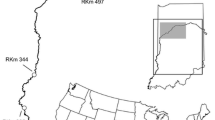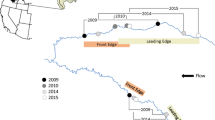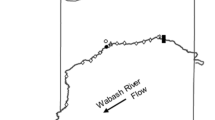Abstract
Unregulated rivers provide unobstructed corridors for the dispersal of both native and invasive species. We sought to evaluate range size and habitat use of an invasive species (Silver Carp, Hypophthalmichthys molitrix) in an unimpounded river reach (Wabash River, IN), to provide insights into the dispersal of invasive species and their potential overlap with native species. We hypothesized that range size would increase with fish length, be similar among sexes, and vary annually while habitats used would be deeper, warmer, lower velocity, and of finer substrate. Silver Carp habitat use supported our hypotheses but range size did not vary with sex or length. 75% home range varied annually, suggesting that core areas occupied by individuals may change relative to climate-based factors (e.g., water levels), whereas broader estimates of range size remained constant across years. Ranges were often centered on landscape features such as tributaries and backwaters. Results of this study indicate habitat and landscape features as potential areas where Silver Carp impacts on native ecosystems may be the greatest. Observed distribution of range sizes indicates the presence of sedentary and mobile individuals within the population. Mobile individuals may be of particular importance as they drive the spread of the invasive species into new habitats.







Similar content being viewed by others

Change history
24 August 2017
An erratum to this article has been published.
References
Abdusamadov, A. S., 1987. Biology of white amur (Ctenopharyngodon idella), silver carp (Hypophthalmichthys molitrix) and bighead (Aristichthys nobilis), acclimatized in the Terek Region of the Caspian Basin. Journal of Ichthyology 26: 41–49.
Aparicio, E. & A. De Sostoa, 1999. Pattern of movements of adult Barbus haasi in a small Mediterranean stream. Journal of Fish Biology 55: 1086–1095.
Baguette, M., S. Blanchet, D. Legrand, V. M. Stevens & C. Turlure, 2013. Individual dispersal, landscape connectivity and ecological networks. Biological Reviews 88: 310–326.
Belica, L. A. T. & F. J. Rahel, 2008. Movements of creek chubs, Semotilus atromaculatus, among habitat patches in a plains stream. Ecology of Freshwater Fish 17: 258–272.
Bengsston, B. O., 1978. Avoiding inbreeding: at what cost? Journal of Theoretical Biology 73: 439–444.
Bennett, A. F., 1987. Interindividual variability: an underutilized resource. In Feder, M. E., A. F. Bennett, W. W. Burggren & R. B. Huey (eds), New Directions in Ecological Physiology. Cambridge University Press, Cambridge: 147–169.
Biro, P. A. & J. A. Stamps, 2008. Are animal personality traits linked to life-history productivity? Trends in Ecology and Evolution 23: 361–368.
Booth, M. T., A. S. Flecker & N. G. Hairston Jr., 2014. Is mobility a fixed trait? Summer movement patterns of Catostomids using PIT telemetry. Transactions of the American Fisheries Society 143: 1098–1111.
Bowering, W. R., 1983. Age, growth, and sexual maturity of Greenland halibut, Reinhardtius hippoglossoides (Walbaum), in the Canadian Northwest Atlantic. Fishery Bulletin 81: 599–611.
Brett, J. R., 1965. The relation of size to rate of oxygen consumption and sustained swimming speed of sockeye salmon (Oncorhynchus nerka). Journal of the Fisheries Board of Canada 22: 1491–1501.
Burt, W. H., 1943. Territoriality and home range concepts as applied to mammals. Journal of Mammology 24: 346–352.
Calkins, H. A., S. J. Tripp & J. E. Garvey, 2012. Linking silver carp habitat selection to flow and phytoplankton in the Mississippi River. Biological Invasions 14: 949–958.
Chen, P., E. O. Wiley & K. M. Mcnyset, 2007. Ecological niche modeling as a predictive tool: silver and bighead carps in North America. Biological Invasions 9: 43–51.
Chick, J. H. & M. A. Pegg, 2001. Invasive carp in the Mississippi River basin. Science 292: 2250–2251.
Clapp, D. F., R. D. Clark Jr. & J. S. Diana, 1990. Range, activity, and habitat of large, free-ranging brown trout in a Michigan stream. Transactions of the American Fisheries Society 119: 1022–1034.
Cooke, S. J., G. T. Crossin, D. A. Patterson, K. K. English, S. G. Hinch, J. L. Young, R. F. Alexander, M. C. Healey, G. Van Der Kraak & A. P. Farrell, 2005. Coupling non-invasive physiological assessments with telemetry to understand inter-individual variation in behavior and survivorship of sockeye salmon: development and validation of a technique. Journal of Fish Biology 67: 1342–1358.
Coulter, A. A., D. Keller, J. J. Amberg, E. J. Bailey & R. R. Goforth, 2013. Phenotypic plasticity in the spawning traits of bigheaded carp (Hypophthalmichthys spp.) in novel ecosystems. Freshwater Biology 58: 1029–1037.
Coulter, A. A., E. J. Bailey, D. Keller & R. R. Goforth, 2016a. Invasive Silver Carp movement patterns in the predominantly free-flowing Wabash River (Indiana, USA). Biological Invasions 18: 471–485.
Coulter, A. A., D. Keller, E. J. Bailey & R. R. Goforth, 2016b. Predictors of bigheaded carp drifting egg density and spawning activity in an invaded, free-flowing river. Journal of Great Lakes Research 42: 83–89.
Crook, D. A., 2004a. Is the home range concept compatible with the movements of two species of lowland river fish? Journal of Animal Ecology 73: 353–366.
Crook, D. A., 2004b. Movements associated with home-range establishment by two species of lowland river fish. Canadian Journal of Fisheries and Aquatic Sciences 61: 2183–2193.
Cudmore, B., N. E. Mandrak, J. M. Dettmers, D. C. Chapman & C. S. Kolar, 2012. Binational ecological risk assessment of bigheaded carps (Hypophthalmichthys spp.) for the Great Lakes Basin. Department of Fisheries and Oceans, Ottawa, Ontario, Canada, No. 2011/114.
DeGrandchamp, K. L., J. E. Garvey & R. E. Colombo, 2008. Movement and habitat selection by invasive Asian carps in a large river. Transactions of the American Fisheries Society 137: 45–56.
Deters, J. E., D. C. Chapman & B. McElroy, 2013. Location and timing of Asian carp spawning in the Lower Missouri River. Environmental Biology of Fishes 96: 617–629.
Downs, J. A. & M. W. Horner, 2007. Network-based kernel density estimation of home range analysis. Proceedings of the Ninth International Conference on Geocomputation, Maynooth, Ireland.
Fieberg, J., 2007. Kernel density estimators of home range: smoothing and the autocorrelation red herring. Ecology 88: 1059–1066.
Fischer, P., 2000. An experimental test of metabolic and behavioural responses of benthic fish species to different types of substrate. Canadian Journal of Fisheries and Aquatic Sciences 57: 2336–2344.
Fish, P. A. & J. Savitz, 1982. Variation in home ranges of largemouth bass, yellow perch, bluegills, and pumpkinseeds in an Illinois lake. Transactions of the American Fisheries Society 112: 147–153.
Fraser, D. F., J. F. Gilliam, M. J. Daley, A. N. Le & G. T. Skalski, 2001. Explaining leptokurtic movement distributions: intrapopulation variation in boldness and exploration. The American Naturalist 158: 124–135.
Funk, J. L., 1955. Movement of stream fishes in Missouri. Transactions of the American Fisheries Society 85: 39–57.
Gallaugher, P., H. Thorarensen & A. P. Farrell, 1995. Hematocrit in oxygen transport and swimming in rainbow trout (Oncorhynchus mykiss). Respiration Physiology 102: 279–292.
Garman, G. C., 1991. Use of terrestrial arthropod prey by a stream-dwelling cyprinid fish. Environmental Biology of Fishes 30: 325–331.
Gerking, S. D., 1950. Stability of a stream fish population. Journal of Wildlife Management 14: 193–202.
Gerking, S. D., 1953. Evidence for the concepts of home range and territory in stream fishes. Ecology 34: 347–365.
Gerking, S. D., 1959. The restricted movement of fish populations. Biological Reviews 34: 221–242.
Goforth, R. R. & J. W. Foltz, 1999. Movements of the yellowfin shiner, Notropis lutipinnis. Ecology of Freshwater Fish 7: 49–55.
Gowan, C., M. K. Young, K. D. Fausch & S. C. Riley, 1994. Restricted movement in resident stream salmonids: a paradigm lost? Canadian Journal of Fisheries and Aquatic Sciences 51: 2626–2637.
Grossman, G. D., A. De Sostoa, M. C. Freeman & J. Lobon-Cervía, 1987. Microhabitat use in a Mediterranean riverine fish assemblage. Oecologia 73: 501–512.
Guisan, A. & W. Thuiller, 2005. Predicting species distribution: offering more than simple habitat models. Ecology Letters 8: 993–1009.
Hansen, E. A. & G. P. Closs, 2005. Diel activity and home range size in relation to food supply in a drift-feeding stream fish. Behavioral Ecology 16: 640–648.
Harrison, P. M., L. F. G. Gutowsky, E. G. Martins, D. A. Patterson, S. J. Cooke & M. Power, 2016. Temporal plasticity in thermal-habitat selections of burbot Lota lota a diel-migrating winter-specialist. Journal of Fish Biology 88: 2111–2129.
Hobbs, N. T. & D. C. Bowden, 1982. Confidence intervals of food preference indices. Journal of Wildlife Management 46: 505–507.
Hobbs, R. C., K. L. Laidre, D. J. Vos, B. A. Mahoney & M. Eagleton, 2005. Movements and area use of belugas, Delphinapterus lencas, in a subarctic Alaskan estuary. Arctic 58: 331–340.
Hoggatt, R. E., 1975. Drainage areas of Indiana streams. U.S. Department of the Interior Geological Survey, Water Resources Division, Indianapolis.
Hollander, M. & D. A. Wolfe, 1999. Nonparametric Statistical Methods, 2nd ed. Wiley, New York.
Hughes, C. L., C. Dytham & J. K. Hill, 2007. Modelling and analysing evolution of dispersal in populations at expanding range boundaries. Ecological Entomology 32: 437–445.
Hutchings, J. A. & L. Gerber, 2002. Sex-biases dispersal in a salmonid fish. Proceedings of the Royal Society of London B: Biological Sciences 269: 2487–2493.
Jackson, D. A., P. R. Peres-Neto & J. D. Olden, 2001. What controls who is where in freshwater fish communities – the roles of biotic, abiotic, and spatial factors. Canadian Journal of Fisheries and Aquatic Sciences 58: 157–170.
Jackson, P. R., 2016. Spatial distribution of depth-averaged velocity measured in the Wabash River near West Lafayette, IN (June 26-27, 2012 and June 17-18, 2013): U.S. Geological Survey data release, http://dx.doi.org/10.5066/F78W3BDQ.
Jayasinghe, U. A. D., E. G. Berthou, Z. Li, W. Li, T. Zhang & J. Liu, 2015. Co-occurring bighead and silver carps show similar food preferences but different isotopic niche overlap in different lakes. Environmental Biology of Fishes 98: 1185–1199.
Kaeser, A. J. & T. L. Litts, 2010. A novel technique for mapping habitat in navigable streams using low-cost side scan sonar. Fisheries 35: 163–174.
Kennedy, G. J. A., 1981. Individual variation in homing tendency in the European minnow, Phoxinus phoxinus (L). Animal Behavior 29: 621–625.
Kocovsky, P. M., D. C. Chapman & J. E. McKenna, 2012. Thermal and hydrologic suitability of Lake Erie and its major tributaries for spawning of Asian carps. Journal of Great Lakes Research 38: 159–166.
Kolar, C.S., D. C. Chapman, W. R. Courtenay Jr., C. M. Housel, J. D. Williams & D. P. Jennings, 2007. Bigheaded carps: a biological synopsis and environmental risk assessment. American Fisheries Society Special Publication 33, Bethesda.
Kolok, A. S., 1999. Interindividual variation in the prolonged locomotor performance of ectothermic vertebrates: a comparison of fish and herpetofaunal methodologies and a brief review of the recent fish literature. Canadian Journal of Fisheries and Aquatic Sciences 56: 700–710.
Lenaerts, A. W., A. A. Coulter, Z. F. Feiner & R. R. Goforth, 2015. Egg size variability in an establishing population of invasive silver carp Hypophthalmichthys molitrix (Valenciennes 1844). Aquatic Invasions 10.
Lester, S. E., B. I. Ruttenberg, S. D. Gaines & B. P. Kinlan, 2007. The relationship between Dispersal ability and geographic range size. Ecology Letters 10: 745–758.
Linfield, R. S. J., 1985. An alternative concept to home range theory with respect to populations of cyprinids in major river systems. Journal of Fish Biology 27: 187–196.
Lockwood, J. L., P. Cassey & T. Blackburn, 2005. The role of propagule pressure in explaining species invasions. Trends in Ecology and Evolution 20: 223–228.
MacNamara, R., D. Glover, J. Garvey, W. Bouska & K. Irons, 2016. Bigheaded carps (Hypophthalmichthys spp.) at the edge of their invaded range: using hydroacoustics to assess population parameters and the efficacy of harvest as a control strategy in a large North American river. Biological Invasions 18: 3293–3307.
Magurran, A. E., 1986. Individual difference in fish behaviour. In Pitcher, T. J. (ed.), The Behaviour of Teleost Fish. Croom Helm, London: 338–365.
Manly, B. F. J., L. L. McDonald, D. Thomas, T. L. McDonald & W. P. Erickson, 2002. Resource Selection by Animals: Statistical Design and Analysis for Field Studies, 2nd ed. Kluwer, London.
McLoughlin, P. D. & S. H. Ferguson, 2000. A hierarchical pattern of limiting factors helps explain variation in home range size. Écoscience 7: 123–130.
Mia, M. Y., J. B. Taggart, A. E. Gilmour, A. A. Gheyas, T. K. Das, K. H. M. Kohinoor, M. A. Rahman, M. A. Sattar, M. G. Hussain, M. A. Mazid, D. J. Penman & B. J. McAndrew, 2005. Detection of hybridization between Chinese carp species (Hypopthalmichthys molitrix and Aristichthys nobilis) in hatchery broodstock in Bangladesh, using DNA microsatellite loci. Aquaculture 247: 267–273.
Minns, C. K., 1995. Allometry of home range size in lake and river fishes. Canadian Journal of Fisheries and Aquatic Sciences 52: 1499–1508.
Moser, M. L. & S. W. Ross, 1995. Habitat use and movements of shortnose and Atlantic sturgeons in the lower Cape Fear River, North Carolina. Transactions of the American Fisheries Society 124: 225–234.
Parsons, D. R., P. R. Jackson, J. A. Czuba, F. L. Engel, B. L. Rhoads, K. A. Oberg, J. L. Best, D. S. Mueller, K. K. Johnson & J. D. Riley, 2013. Velocity mapping toolbox (VMT): a processing and visualization suite for moving-vessel ADCP measurements. Earth Surface Processes and Landforms 38: 1244–1260.
Peters, R. H., 1983. The Ecological Implications of Body Size. Cambridge Press, Toronto.
Peterson, A. T., 2003. Predicting the geography of species’ invasions via ecological niche modelling. The Quarterly Review of Biology 78: 419–433.
Phillips, S. J. & M. Dudík, 2008. Modeling of species distributions with Maxent: new extensions and a comprehensive evaluation. Ecography 31: 161–175.
Pritchett, J. & M. Pyron, 2011. Predicting fish assemblages form substrate variation in a turbid river: grab samples compared to pole probing. North American Journal of Fisheries Management 31: 574–579.
Radinger, J. & C. Wolter, 2014. Patterns and predictors of fish dispersal in rivers. Fish and Fisheries 15: 456–473.
Rhodes, J. R., C. A. McAlpine, D. Lunney & H. P. Possingham, 2005. A Spatially explicit habitat selection model incorporating home range behaviour. Ecology 86: 1199–1205.
Rodríguez, M. A., 2002. Restricted movement in stream fish: the paradigm is incomplete, not lost. Ecology 83: 1–13.
Roy, M. L., A. G. Roy, J. W. A. Grant & N. E. Bergeron, 2013. Individual variability in the movement behavior of juvenile Atlantic salmon. Canadian Journal of Fisheries and Aquatic Sciences 70: 339–347.
Schrank, S. J., P. J. Braaten & C. S. Guy, 2001. Spatiotemporal variation in density of larval bighead carp in the lower Missouri River. Transactions of the American Fisheries Society 130: 809–814.
Silva, A. T., C. Katopodis, J. M. Santos, M. T. Ferreira & A. N. Pinheiro, 2012. Cyprinid swimming behaviour in response to turbulent flow. Ecological Engineering 44: 314–328.
Skalski, G. T. & J. F. Gilliam, 2000. Modeling diffusive spread in a heterogeneous population: a movement study with stream fish. Ecology 81: 1685–1700.
Stuck, J. G., A. P. Porreca, D. H. Wahl & R. E. Columbo, 2015. Contrasting population demographics of invasive Silver Carp between an impounded and free-flowing river. North American Journal of Fisheries Management 35: 114–122.
Thomas, D. L. & E. J. Taylor, 1990. Study designs and tests for comparing resource use and availability. Journal of Wildlife Management 54: 322–330.
Travis, J. M. & C. Dytham, 2002. Dispersal evolution during invasions. Evolutionary Ecology Research 4: 1119–1129.
Tyler, J. A. & J. F. Gilliam, 1995. Ideal free distributions of stream fish: a model and test with minnows Rhinicthys atratulus. Ecology 76(5): 80–592.
USACE (United State Army Corps of Engineers), 2010. Great lakes and Mississippi river interbasin study: other pathways preliminary risk characterization. U.S. Army Engineer District, Louisville, Kentucky. http://glmris.anl.gov/documents/docs/Other_Pathways_Risk.pdf. Accessed 19 December 2014.
Vogel, S., 1996. Life in Moving Fluids: The Physical Biology of Flow. Princeton University Press, Princeton.
Waldman, B. & J. S. McKinnon, 1993. Inbreeding and outbreeding in fishes, amphibians, and reptiles. In Thornhill, N. W. (ed.), The Natural History of Inbreeding and Outbreeding: Theoretical and Empirical Perspectives. University of Chicago Press, Chicago: 250–282.
Wetzel, R. G., 2001. Limnology: Lake and River Ecosystems, 3rd ed. Academic Press, San Diego.
Winemiller, K. O. & D. B. Jepsen, 1998. Effects of seasonality and fish movement on tropical river food webs. Journal of Fish Biology 53: 267–296
Woolnough, D. A., J. A. Downing & T. J. Newton, 2009. Fish movement and habitat use depends on water body size and shape. Ecology of Freshwater Fish 18: 83–91
Wright, D., L. B. Rimmer, V. L. Pritchard, R. K. Butlin & J. Krause, 2003. Inter and intra-population variation in shoaling and boldness in the zebrafish (Danio rerio). Journal of Fish Biology 63: 258–259.
Acknowledgements
Funding for the telemetry portion of this study was provided by the Indiana Department of Natural Resources (EDS E2-1-D639) and the Great Lakes Restoration Initiative. We thank Doug Keller, Tom Stefanavage, and Craig Jansen for assisting in the execution of this project and Zachary Feiner for coding help. We also thank the many Goforth lab students and technicians at Purdue University as well as United States Geological Survey Indiana-Kentucky Water Science Center personnel for assistance in the field. We appreciate the feedback and guidance provided by anonymous reviewers of this manuscript and E. Murphy. A. Coulter was supported by a Graduate Assistance in Areas of National Need fellowship and a Purdue University Department of Forestry and Natural Resources Ross Fellowship during the completion of this work. Funding from the National Institute of Food and Agriculture also supported R. Goforth and the Goforth lab during this study. Any use of trade, firm, or product names is for descriptive purposes only and does not imply endorsement by the U.S. Government.
Author information
Authors and Affiliations
Corresponding author
Additional information
Handling editor: Andrew Dzialowski
An erratum to this article is available at https://doi.org/10.1007/s10750-017-3348-3.
Rights and permissions
About this article
Cite this article
Prechtel, A.R., Coulter, A.A., Etchison, L. et al. Range estimates and habitat use of invasive Silver Carp (Hypophthalmichthys molitrix): evidence of sedentary and mobile individuals. Hydrobiologia 805, 203–218 (2018). https://doi.org/10.1007/s10750-017-3296-y
Received:
Revised:
Accepted:
Published:
Issue Date:
DOI: https://doi.org/10.1007/s10750-017-3296-y



